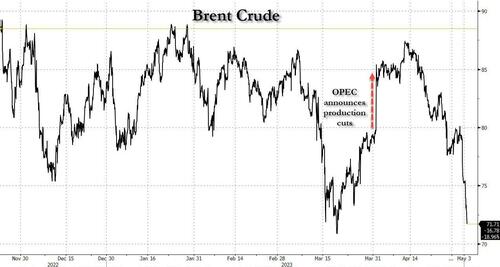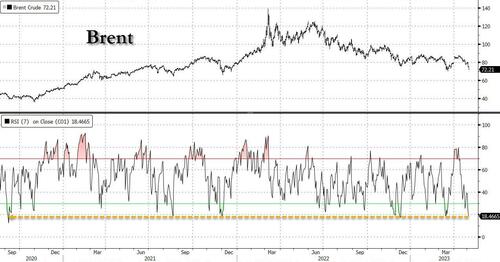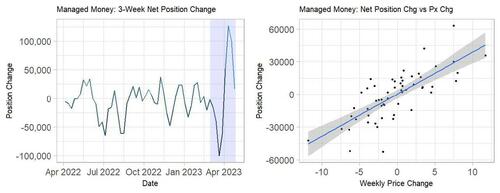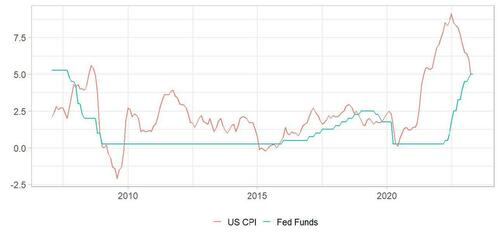Oil Plunges To Most Oversold In Two Years Amid CTA Shorting Frenzy
One of the most popular mainstream explanations behind the recent plunge in oil, is that the price is dumping on expectations of a US – and global – recession (the slow rebound in China isn’t helping) which will throttle oil demand and has turned investors even more bearish and caused refining margins to slump. There is just one problem with this “explanation”: oil, as a spot commodity, doesn’t trade based on discounting the future, but on supply and demand dynamics in the here and now, and unless one claims that the BEA has manipulated a deeply negative real GDP print into the latest +1.1% print (which translates into 5.1% nominal growth), there is no way that oil is currently seeing such a sharp drop in demand.
Which leaves financial speculation as the other explanation.
In a note from Goldman’s commodities desk today, we read that “crude oil is taking the brunt of the ‘macro’ pain again to start the London session and while people point to the slightly softer ytd fundamentals out of the US / China inventories scanning quite high.” The bank then goes on to note that we that “similar to the selloff in the middle of march most of this move is the result of positioning set up. Specifically, the US producer community was quite active following the OPEC ‘surprise’ cut.. and we are moving through producer strike levels in both WTI and Brent. Add to the mix 1) a top trade on the year has been short crude vol.. and 2) CTAs flipped from max short to nearly max long… and the reversal back down has been swift.“
And speaking of positioning, the Goldman desk also notes that RSI has been a good indicator of entry points on the previous sell-offs, and “we are getting closer” to where the CTAs get squeeze again: after all, as shown below, the 7-day RSI in oil as now approaching record lows!
Going back to the influence of momentum on the price of oil, here is a note from Marex commodity strategist Ryan Fitzmaurice who looks at the impact of momentum systems on the price of oil. We excerpt from the full note below (available to pro subs in the usual place).
Momentum trading systems are prevalent across almost all liquid futures markets and their price influence can be obvious at times. That certainly is the case with oil futures recently, as is clear from the wild swings in the CFTC market positioning data. As many are aware, the Commitment of Traders report disaggregates positions into four distinct categories: Money Managers, Other Reportables, Producer/Merchant, and Swap Dealers. Many systematic momentum funds are considered money managers, and this is clear when analyzing the trading behavior of this group with respect to price changes. There are also other factors that influence their trading behavior beyond price, such as changes in volatility and correlations, but in general, money managers buy when prices are going up and sell when prices are going down in classic momentum chasing fashion.
This can work well when markets are trending strongly, but oil markets have been quite choppy lately. As a result, many momentum systems have gotten whipsawed by the volatile price action. In March, the US regional banking troubles sent oil prices tumbling and with that many systematic funds got “short” on bearish momentum signals. In fact, the combined gross “short” held by money managers for ICE Brent and Nymex WTI rose by 96k contracts during the first three weeks of March. Then came the OPEC+ surprise cut which sent oil prices gapping higher, triggering “short” covering with the gross “short” dropping by -126k contracts in the three weeks following the news. This aggressive buying and selling in such a short period of time has undoubtedly exacerbated the oil price action recently, a dynamic we expect to continue this year.
Thinking Ahead
As noted, we expect momentum funds to continue to exert influence on oil prices this year. In fact, oil prices weakened right after the buying from managed money “short” covering faded. Importantly, oil momentum signals are now bearish again on most key timeframes, and already we are seeing some fresh “shorts” being added back by this influential group. On Tuesday, oil prices fell sharply in what felt like aggressive systematic selling. In addition to that, US regional bank failures, debt ceiling concerns and recession fears continue to weigh on oil prices, while a weak April Chinese PMI print has also hurt sentiment despite record crude processing in March. Interestingly, these newly established “shorts” come just ahead of Wednesday’s key FOMC rate decision.
The market is currently pricing in a +25bp hike, which would take the upper bound to 5.25%. If market expectations are met, this would leave the Fed Funds rate at the highest level since 2007, just before the global financial crisis. More importantly, this would put the Fed Funds rate above the latest US CPI print which showed y/y consumer inflation of 5% in March and with current expectations for that level to hold in April. That would take real interest rates into positive territory for the first time since 2019. In theory, that should take some pressure off the Fed in the near term, potentially allowing for a pause to assess the economic impact of the fastest hiking cycle in decades. As for oil prices, a Fed pause could shift the focus away from the macro concerns and towards more traditional supply and demand factors
If the US Fed hikes interest rates by +25bp as expected on Wednesday, real rates would be in positive territory for the first time since 2019…
More in the full note available to pro subs in the usual place.
Tyler Durden
Wed, 05/03/2023 – 12:19
Zero Hedge’s mission is to widen the scope of financial, economic and political information available to the professional investing public, to skeptically examine and, where necessary, attack the flaccid institution that financial journalism has become, to liberate oppressed knowledge, to provide analysis uninhibited by political constraint and to facilitate information’s unending quest for freedom. Visit https://www.zerohedge.com




